If you're an affiliate marketer, promoting products on Twitter may have crossed your mind.
The answer is yes! It's a good idea. At Typefully, we'll show you everything you need to know about affiliate marketing on Twitter – like how to perfect your profile, create valuable content, and engage a monetizable audience.
Ready? Let's go.
What Is Affiliate Marketing On Twitter?
Affiliate marketing is a type of online marketing where you promote products or services on behalf of another company and receive a commission for each sale that you generate.
It's a great way to earn money online, and it can be done in a variety of ways – on Twitter, it means promoting products to your Twitter followers through tweets or threads, instead of people visiting your website or other social media platforms.
In this guide, we'll show you how to get started with affiliate marketing on Twitter, so you can start earning commissions from the products or services that you promote.
Why should affiliates use Twitter?
- Easier to get noticed with more organic reach. Other platforms like Facebook and Instagram favor paid promotions over organic reach. Twitter doesn't push promoted tweets as hard. So it's easier for smaller accounts to go viral with enough engagement.
- There's less competition. The Pew Research Center found that only 10% of Twitter users create about 80% of the content – so it's easier to cut through the noise when you're affiliate marketing on Twitter.
- 52% of Twitter users have purchased items after seeing them on the platform. You have a good chance of attracting people who will likely buy a product in the future after seeing it featured in relevant tweets – aka, your affiliate marketing efforts.There's money to be thrown around. Did you know that over 25% of Twitter users make $75,000 a year? It would be smart to tap into a platform that has a large number of potential customers with enough disposable income to consider your affiliate products, wouldn't it?
Related: (2022) 10 Unique Benefits of Twitter for Your Business
How many followers do you need to make money on Twitter?
While a great start would be to have a couple of thousand followers, remember that there's no concrete number that will guarantee your affiliate revenue.
To be honest, it's the wrong question. What you should really be looking at is a healthy ratio between the size of your audience and engagement rate. A smaller following that engages more with your Twitter account is more valuable than having a lot of followers who don't interact with your stuff.
It's important not to forget that 74% of people use Twitter for entertainment. This should remind you to produce entertaining content that your followers will find valuable and appreciate. If they think you're just trying to get them to spend money without any organic interaction, they're going to tune you out real quick.
1. Make a lasting impression with your Twitter profile
Your profile is the first thing that people will see when they come across your Twitter account – so it needs to make a good impression, like a landing page would for a website.
Here are some things you can do to make Twitter profile look credible and relevant with CTAs:
- Make sure your profile picture is clear and easy to see. Use a close-up headshot or logo for best results. It's easier to get people to trust you when there's a friendly face behind the content – it's more genuine.
- Choose a catchy profile header. This is the large image at the top of your profile, so make sure it's something that will grab attention.
- Write a persuasive bio. Keep it short and sweet, but make sure to include keywords that describe what you do and what kind of content people can expect from you.
- Even mentioning where you're from adds a level of closeness with your followers.
- While you're at it, you can also drop any past or present employers, pin your most popular tweet, and list any known platform where your work has been featured for that extra bit of credibility.
- Include a link to your website or landing page. This is essential if you want people to take you seriously as an affiliate marketer – it adds authenticity to your Twitter profile. If you're promoting products on your website, make sure to use a call-to-action (CTA) in your bio so people know what to do next. Something like "Check out our website for the latest deals!" would suffice.
2. Blend affiliate products in with stories and context (using Twitter threads)
When it comes to promoting products on Twitter, it's important that you don't just make a tweet that looks like an ad. That's a surefire way to get less engagement and lose followers.
Instead, try to blend the products in with stories and context. This could look like threading tweets together to tell a story, and in between those tweets, you can promote products that are relevant to the story. In fact, Twitter threads get 63% more impressions and 54% more engagement.
For instance, @philostar, founder of 4 day week, publishes a thread on how he grows his job platform through SEO, shows the relevant stats, and plugs in the affiliate link of the SEO marketing agency that’s helped him succeed. Hook, line and sinker.
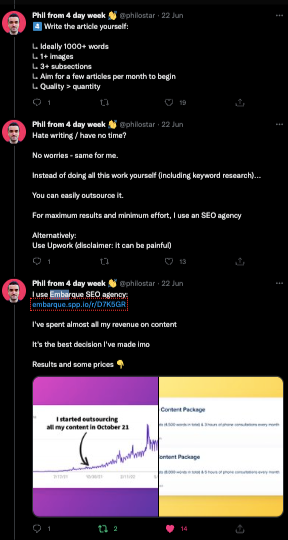
You can use Typefully to edit a well-crafted thread (made faster with convenient hotkeys), rearrange any tweets, add the appropriate media and links, and visualize everything all in one Google doc-like canvas before you publish:
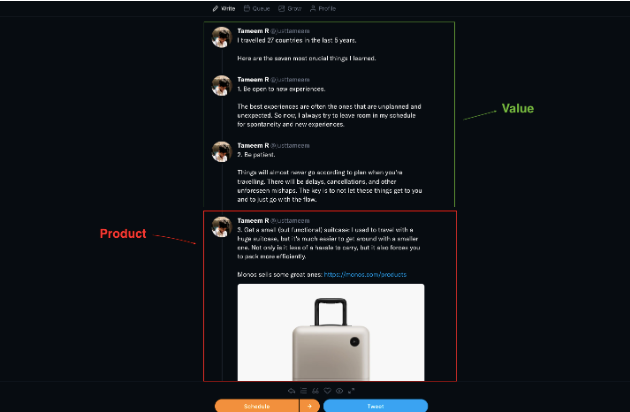
When you do it like this, it doesn't feel like you're shoving a product down people's throats. Instead, it feels like you're just sharing your experience and letting people know what products you used – which is much more organic and genuine.
3. Don't just paste affiliate links, link to your content.
If you're just pasting affiliate links into your tweets, people are going to catch on and they're not going to click them. They don't know where that link is going to take them and if it's even safe. Besides, considering lone tweets only go up to 180 characters, you're going to come off way too sales-y doing this over time.
Instead of just sharing the affiliate link, share a link to your own content – which could have affiliate links in them. So this could be a blog post or YouTube video that lists the best products for something. This way, you're sharing valuable content with your followers while also promoting the product you're an affiliate for.
You can get people to click on your content and make it more share-worthy by:
- Using visual content when possible: People are more likely to click on tweets with images (e.g, infographics and videos), so add one whenever you can.
- Asking questions: Pose a question that gets people thinking and wanting to know more.
- Drop quotes, statistics, tips, and insights: These are all things that can be a 'wow factor' to make people click on your content so they can learn more.
- Mention key excerpts that are interesting and high-value from your blog posts and other long-form content.
If you look at the example below, you’ll see some of the tips in action. Notice how there are no direct affiliate links. Instead, the tweet serves as a showcase for what the user can expect from the (affiliate) content so they will click on it.
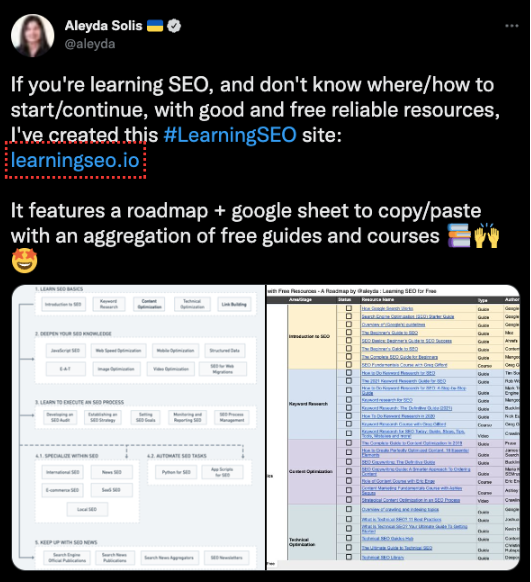
Make sure the content you're linking to is high quality and relevant to what you're tweeting about. If it's not, people are going to see right through it and they're not going to click the link.
4. Read into your performance metrics to maximize results
You can't improve what you can't measure, right? The good news is that Twitter provides a lot of analytics about your tweets, so you can see what's working and what's not. Depending on what your goals are with affiliate marketing, you'll want to focus on different metrics.
For example, if your goal is to get more clicks and traffic to your website, then you'll want to track when you get the most engagement. Typefully shows you this data with easy-to-read graphical displays on when users interact most with your tweets during the day and even month.
This will give you a good idea of when to tweet your affiliate marketing-related content.

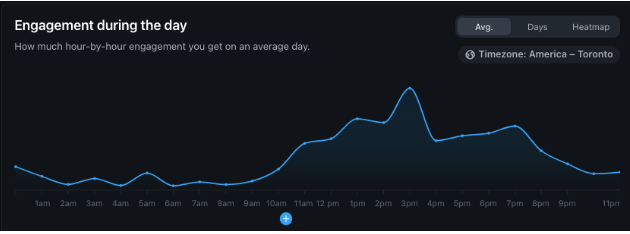
You can then schedule your tweets for publication at the optimal times straight from the Typefully editor.
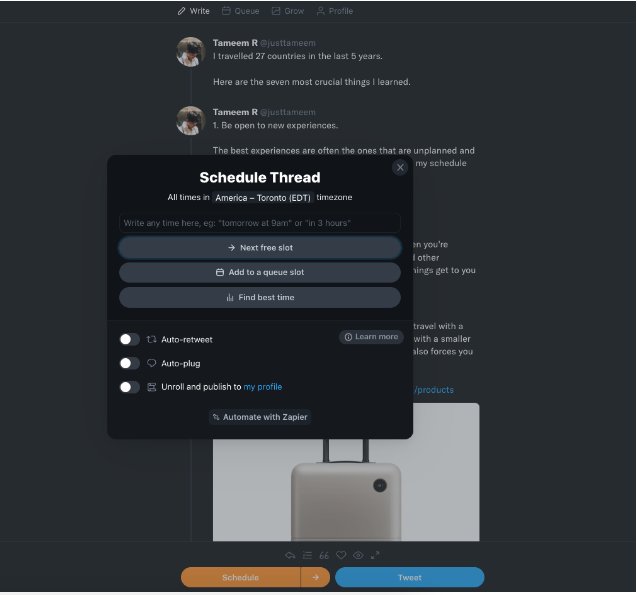
5. Live in the moment and capitalize on trends
Twitter is a very fast-paced platform by nature, which means things move quickly. If you're not paying attention, you could miss out on a huge opportunity for your affiliate marketing campaign.
For example, if there's a holiday coming up, something big happening in the news, or maybe there’s a topic in high demand from your community of followers – you can use these scenarios as an opportunity to tweet out relevant content. You could even do a Twitter thread on it if you have enough to say. Like this guy:
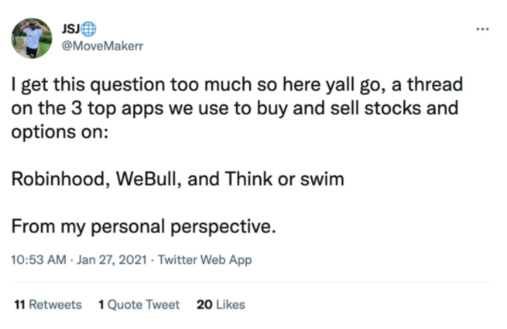
In the first tweet, the thread is set up, and the last tweet links out to YouTube reviews that contain affiliate links.

This way, you're staying in the moment and providing value to your followers while also promoting your affiliate products.
Twitter is actually rolling out a keyword alerts feature where you'll be notified whenever someone tweets about that topic. That way, you can join any trending conversations about your product or niche and share your own thoughts (and content) on the matter.
Read: (2022) How to See Worldwide Trends on Twitter
6. Talk to people
Twitter is a social platform, so you should be engaging with people – not just promoting your affiliate products. If all you're doing is tweeting out links to your content or product pages, you're going to come off as spammy pretty quickly.
Get involved in conversations, follow other users, share other people's content, and RT (retweet) things you like. This way, you're building relationships with other users and becoming part of the Twitter community. When you do share your own content, people are more likely to pay attention because they know who you are.
And when you're engaging with people, don't forget to actually listen to what they're saying. This way, you can get valuable feedback about your products or content and use that to improve your affiliate marketing strategy.
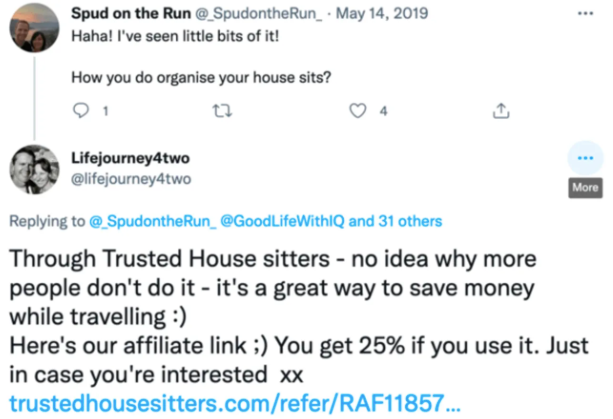
Use Typefully to make affiliate content marketing easier
Twitter is a great platform for affiliate marketing because it's so fast-paced and there's always something new going on. By following the tips above, you can make sure you're promoting your products in the best way possible.
Many successful Twitter affiliate marketers grow their audience with powerful features on Typefully like the editing and publishing capabilities along with detailed analytics about your performance.
You can try it for free today here.